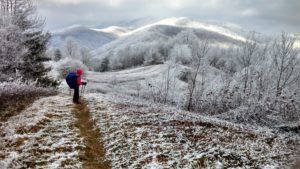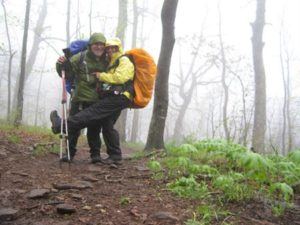Safety
Weather Hazards
Weather conditions can change quickly on all sections of the Appalachian Trail. Being prepared will help ensure you stay safe even when the weather takes a turn for the worse.
Snow

Photo by Robert Killian
Virtually every part of the Trail has the potential to receive snowfall through early April. Winter-like weather often occurs in late spring or early fall in the southern Appalachians, Vermont, New Hampshire, and Maine. Mountains in the South, especially those above 5,000 feet, can receive snowfall – sometimes deep. The highest peaks in Tennessee, North Carolina, and southwest Virginia receive an average of close to 100 inches of snowfall a year.
In the northern Appalachians, it can snow during any month of the year. In Maine and New Hampshire, snow can linger until June. The locations that receive the most snow are often the most remote. Be prepared for the conditions you may encounter.
The following websites can help you become acquainted with weather patterns along the Appalachian Trail:
- National Weather Service National Snowfall Analysis – Current and archived snow maps and other data on snow
- ATWeather.org – Weather forecasts for shelters along the A.T.
- Great Smoky Mountains National Park Weather – Average high and low temperatures, average snowfall by month, weather data from the last 24 hours for the highest mountains on the Trail (in Tennessee and North Carolina)
- Mt. Washington Observatory – Weather data at the summit of the highest peak on the A.T. in New England and Higher Summits Forecast – Forecasts for elevations of 4,000 ft and above in the White Mountains
- Weathercarrot’s AT Snow Maps – Average annual snowfall for the entire A.T.
Hypothermia
 A cold rain can be the most dangerous weather for hikers, because it can cause hypothermia (or “exposure”) even when conditions are well above freezing. When the wind blows, its chill effect can make you much colder than the temperature would lead you to suspect, especially if you’re sweaty or wet. Hypothermia occurs when wind and rain chill the body so that its core temperature drops if the condition is not treated in time.
A cold rain can be the most dangerous weather for hikers, because it can cause hypothermia (or “exposure”) even when conditions are well above freezing. When the wind blows, its chill effect can make you much colder than the temperature would lead you to suspect, especially if you’re sweaty or wet. Hypothermia occurs when wind and rain chill the body so that its core temperature drops if the condition is not treated in time.
Avoid hypothermia by dressing in layers of synthetic clothing, eating well, staying hydrated, and knowing when to take refuge in a warm sleeping bag and tent or shelter. Cotton clothing, such as blue jeans, tends to chill you when it gets wet from rain or sweat, increasing your risk of hypothermia. Natural wool and artificial fibers such as nylon, polyester, and polypropylene all do a much better job of insulating your body in cold, wet weather.
Heat
 Hot, humid conditions are common along the Trail in summer, particularly in the Virginias and the mid-Atlantic and at lower elevations of the South and New England. Significant amount of body fluid can be lost in the exertion of strenuous climbs, especially when carrying a heavy pack in hot weather. In humid conditions, sweat does not evaporate well and does not cool the body effectively. Hikers may face the danger of heat stroke and heat exhaustion if they haven’t taken proper precautions.
Hot, humid conditions are common along the Trail in summer, particularly in the Virginias and the mid-Atlantic and at lower elevations of the South and New England. Significant amount of body fluid can be lost in the exertion of strenuous climbs, especially when carrying a heavy pack in hot weather. In humid conditions, sweat does not evaporate well and does not cool the body effectively. Hikers may face the danger of heat stroke and heat exhaustion if they haven’t taken proper precautions.
Common types of heat problems:
- Sunburn: Occurs rapidly and can be quite severe at higher elevations; hikers in the Virginias and southern Appalachians are often surprised by bad sunburn in spring, when no leaves are on the trees.
- Heat Cramps: Usually caused by strenuous activity in high heat and humidity, when sweating depletes salt levels in blood and tissues. These can be painful and even immobilizing.
- Heat Exhaustion: Occurs when the body’s heat-regulating system breaks down. A victim may have heat cramps, sweat heavily, have cold, moist skin, and a face that is flushed, then pale.
- Heat stroke: A life-threatening condition that occurs when the body’s system of sweating fails to cool a person adequately. Body temperature can rise to 106 degrees or higher.
How to Prevent Heat-Related Illnesses:
- Plan ahead and be conservative. Long daylight hours may tempt you to plan a long hike; choose a shorter, less extreme one when the heat index is high. Be mindful of the need to rest and allow the body to recover from the demands of hot-weather hiking.
- Stay Hydrated. Start your hike well hydrated and carry plenty of water. You may need three quarts or more during the day. Bring along more than you think you need–someone else may need it if you don’t.
- Consume electrolytes: Make sure you have salty snacks, fresh fruit, or a sports drink.
- Start early in the day: If you are climbing a big mountain, plan your ascent for the early morning hours when temperatures are cooler, and the descent in the heat of the day. If the morning gets away from you, choose a shorter, less strenuous hike.
- Take a siesta mid-day: If you are backpacking or doing a long day hike, take a long nap when temperatures are hottest.
- Take frequent rest stops. Hiking in hot, humid conditions can be exhausting.
- Monitor your urine output and color. If you’re not urinating on a regular basis, it’s your body’s indicator to drink more. Generally urine should be very light yellow; darker yellow is usually a sign you are becoming dehydrated (this can be affected by medications, diet, or other conditions).
- Drink frequently, but small amounts. It’s important to stay hydrated, but it’s possible to overdo it. Drinking excessive amounts of water beyond what the body needs can cause a serious condition known as hyponatremia.
- Keep an eye on your hiking partners. If you’re with a group, pay close attention to how all members are doing and make sure they are drinking enough. Someone who is not as fast or fit as others may be reluctant to stop and drink for fear of lagging behind, or may refrain from drinking because they are uncomfortable urinating in the woods. If a hiker is struggling to keep up in the heat this could lead to a bad outcome. Be prepared to end the hike early.





